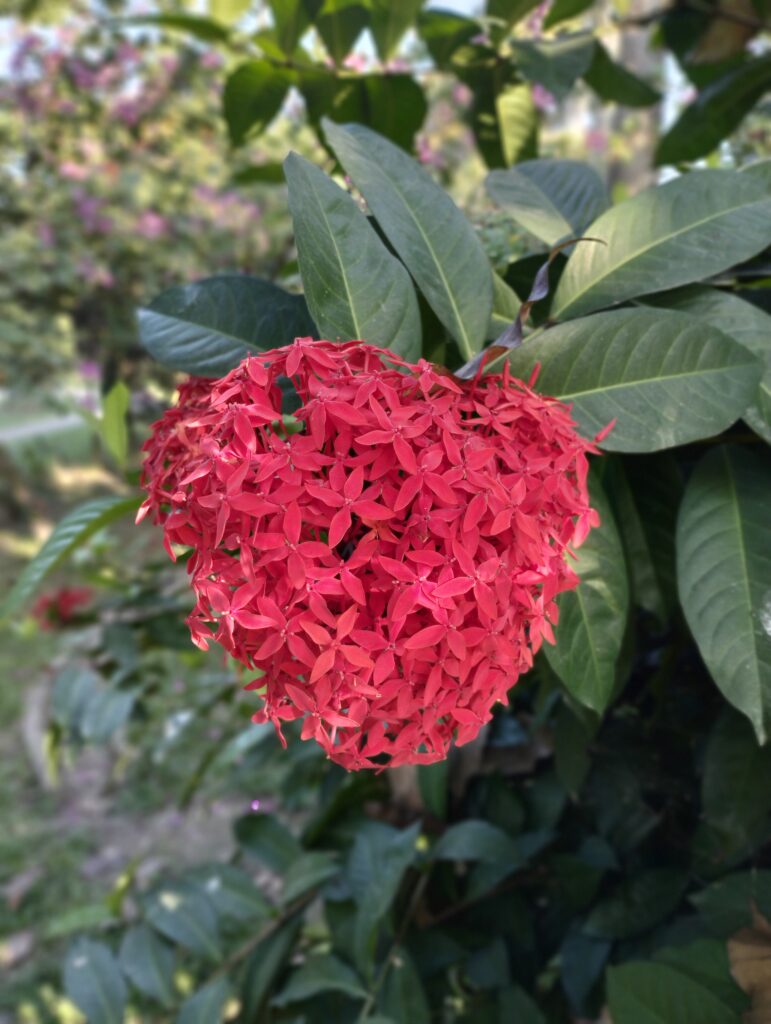Suriname
Ixora “Faja Lobi”
Ixora coccinea

General Description / Cultural Significance
The Ixora (Ixora coccinea) is a native shrub that blooms year-round with clusters of vibrant, four-petaled fragrant flowers. As the national flower of Suriname, it holds significant commercial value due to its extensive array of phytochemicals found in all parts of the plant, including the flowers, stems, leaves, fruit, and roots. These components are utilized in traditional medicine and Ayurveda to treat various medical conditions such as skin diseases and diabetes. The roots, in particular, are known for their diuretic properties and are used as remedies for nausea, appetite stimulation, and bronchitis when steamed and inhaled or consumed as tea. This widespread use has led many people in Suriname to deeply appreciate and value the essence of the Ixora.
The plant itself features a cluster of sturdy branches, thin and limp oval leaves, and distinctive tubular flowers that come together in dense, round clusters. Typically, Ixora plants grow between 4 and 6 feet tall, though they can reach up to 12 feet with proper support.
In Suriname, the Ixora plant symbolizes wealth and success. It is often associated with love, passion, and spirituality, and is used in religious celebrations where it is offered to deities. The scarlet red color of its flowers is meant to signify unrelenting spiritual devotion. The scent of Ixora is frequently compared to gardenia, offering a floral, zesty, and sweet aroma. Its nectar, which can be eaten like honeysuckle, adds to its appeal. Beyond their practical applications, many families grow these shrubs around their homes and use them as houseplants, believing they foster love and life in intimate spaces while providing a delightful fragrance to any environment they inhabit.
Climate Change / Conservation Status
Suriname is highly vulnerable to the impacts of climate change. Imminent sea level rise, coastal erosion, and flooding, along with decreased rainfall, make it challenging to predict and maintain soil consistency and plant health. These changes threaten local water security and adversely affect agriculture, including the cultivation of plants such as the Ixora.
Alternate Names
Flame of the Woods
Jungle Flame
Jungle Geranium
Viruchi
Rangan
Pendkuli
Sources
Housing News DeskHousing News Desk is the news desk of the leading online real estate portal. “Ixora Coccinea: Bright Red Tropical Flower.” Housing News, Housing.com, 13 Mar. 2023, housing.com/news/jungle-geranium-the-evergreen-flowering-cousin-of-coffee-beans/.
“Jungle Flame (Ixora Coccinea).” iNaturalist, iNaturalist Network, www.inaturalist.org/taxa/133309-Ixora-coccinea. Accessed 7 May 2024.
Maniyar, Yasmeen, et al. “Antidiarrheal Activity of Flowers of Ixora Coccinea Linn. in Rats.” Journal of Ayurveda and Integrative Medicine, U.S. National Library of Medicine, Oct. 2010, www.ncbi.nlm.nih.gov/pmc/articles/PMC3117321/#:~:text=Roots%20and%20flowers%20are%20used,sores%2C%20eczema%2C%20chronic%20ulcers.
Office of the Ambassador, Permanent Mission of the Republic of Suriname to the United Nations. Full statement in World Sensorium’s original website.
World Conservation Monitoring Centre. “The IUCN Red List of Threatened Species.” IUCN Red List of Threatened Species, IUCN, 1 Jan. 1998, www.iucnredlist.org/species/38014/10092131.

